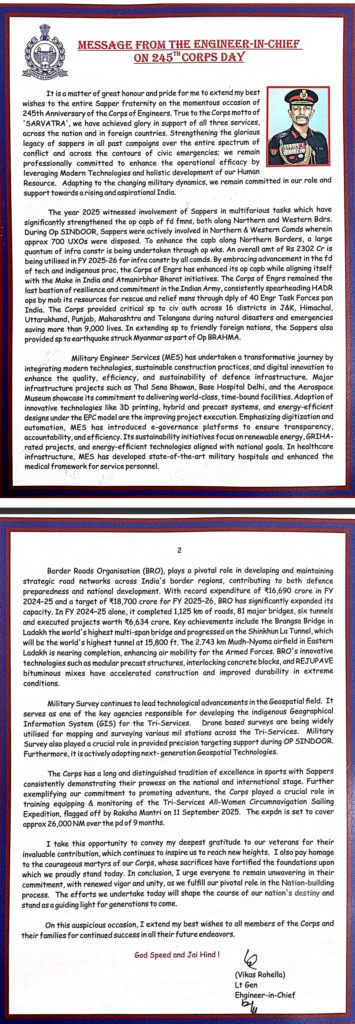All posts by webadmin
55 ENGINEER REGIMENT (DELHI-NCR )GTG 16 NOV 2025
Col NK Sharma write

GTG today at AVI Noida.
It takes great efforts to organize by Veterans.
We are grateful to Maj SPS Rathore who came from Lucknow, Sushil from Jammu, Chand from Mathura.
It was a great feeling to have Brig Manpreet Singh Dhillon Son of Col Amar Jeet Singh Dhillon , OC HQ Coy in Amritsar, among us.
60th Raising Day, Diamond Jubilee Celebrations due next year was briefly discussed.
One thought is to celebrate Diamond Jubilee in Delhi Cantt and the responsibility to be taken by Serving Officers.
Enthusiast and Josh is quite good and high for the same.
Some of the photographs taken are share

BEAUTIES OF 55 ER


COL RN Khanna writes
GTG: DELHI-NCR
16th Nov.
1.PACHPANITES VETERANS have settled in specific areas. When I mooted & designated four separate CHAPTERS for ease of conducting GTGs, initially it looked odd. But it has worked & serving the purpose.
- During the last few years GTGs being organised by each CHAPTER, have caught on & have become rituals.
Participation & enthusiasm has also increased. Idea of Inviting the EXTENDED FAMILY members has caught on to associate the next generation. The atmosphere, atleast in Delhi-NCR, is so free & frankly Joice. - Though it takes lots of effort on the part of the organising team, as well as PACHPANITES, some of them coming from far off cities. All this ought to be appreciated.
- While chasing & pursuing PACHPANITES on individual basis by organising team members, (some times several times) we come to know the constraints of some for not able to attend & some times last minute drop outs.
- While on this exercise, 6 veterans, who were unable to attend this time, sent me their best wishes, which were read by two members of the organising team.
Brig Hira Singh was badly off & was not able to even speak to me. So he sent his wishes in writing & posted on my WhatsApp. 😊 - I mooted the idea of having next year’s DELHI-NCR GTG in Delhi , through general consensus.
Could be syncrinised with the 60th Raising Day date with max participation. We can even think of combining DELHI-NCR & PUNJAB Chapters.
It’s a long call, which has to be taken by Gaurav & Vijay. Long way & plenty of time to have views, discussion & plan.
Let us hope for the next grand GTG. - God bless PACHPANITES & PACHPAN AJA
ENGINEER-IN-CHIEF MESSAGE ON 245th CORPS DAY
Army plans women induction into TA, may go with few units initially

The Territorial Army in its present form was established under the Territorial Army Act on August 18, 1948
The Army is considering the induction of women into Territorial Army (TA) battalions as a pilot project, with recruitment initially restricted to a few units.
Army sources confirmed the developmenton Sunday, saying the intake would begin with small numbers and may expand after an evaluation of the scheme. They emphasised that the TA is not deployed on front-line battle roles.
Currently, women are commissioned into 10 arms and services — the Corps of Engineers, Corps of Signals, Army Air Defence, Army Service Corps, Army Ordnance Corps, Corps of Electronics and Mechanical Engineers, Army Aviation Corps, Intelligence Corps, Judge Advocate General Branch and Army Education Corps, in addition to the Armed Forces Medical Services.
Women are not inducted into the infantry or armoured corps.
The Territorial Army, raised as a “citizen soldiers’ force”, allows able-bodied volunteers — particularly those overage for regular Army enrolment — to serve the nation in uniform while augmenting the Army’s organisational needs.
At present, the Territorial Army has a strength of around 50,000 personnel comprising 65 Departmental TA units such as Railway, IOC, ONGC, and Non-Departmental TA units of Infantry Battalion (TA), including Home and Hearth Battalions, Ecological Battalion (TA) affiliated to various Infantry Regiments and Engineer Regiment (TA) for maintenance of Line of Control fencing.
TA units have participated in the 1962, 1965 and 1971 operations, and played active roles in Operation Pawan in Sri Lanka, Operation Rakshak in Punjab and Jammu & Kashmir, and Operation Rhino and Operation Bajrang in the North-East.
The Territorial Army in its present form was established under the Territorial Army Act on August 18, 1948, and was formally inaugurated by C Rajagopalachari on October 9, 1949.
Defence Ministry mulls retaining more Agniveers

A proposal on the Agnipath scheme is being examined on three key points — providing financial support to family in case of death, lifelong medical treatment in case of disability and an increase in the number of those being retained after the four-year tenure ends.
The Department of Military Affairs, which falls under the Ministry of Defence and is headed by Chief of Defence Staff General Anil Chauhan, is now examining a proposal to tweak the Agnipath scheme on three key points — providing financial support to family in case of death, lifelong medical treatment in case of disability and an increase in the number of those being retained after the four-year tenure ends.
Sources said a decision was expected soon as the first lot of Agniveers – the name of soldiers recruited under the scheme – would complete their four-year tenure in October next year.
The armed forces have made a pitch for increasing the retention percentage of soldiers. The Agnipath scheme entails the recruitment of youth in the armed forces for four years. After the period, 25 per cent of the recruits would be retained as full-time soldiers, while others will be relieved of the service.
The three services want that ceiling of retaining 25 per cent soldiers be increased. Sources said the suggestion of the forces is to retain 50 per cent of the recruits in all arms and 60 per cent in case of technical arms.
The move comes as all the three forces are rapidly absorbing technology and need more trained hands to operate UAVs, scan surveillance footage and read radars signals to launch air defence mechanisms like in Operation Sindoor.
Also, in case of an Agniveer dying in the line of duty, his family be given a “subsistence allowance” for life, is part of the proposal. Since those recruited under the scheme cannot marry, the proposal does not mention the wife as a beneficiary.
Under the proposal, Agniveers who get disabled in line of duty are to be made entitled for benefits like regular soldiers who get free medical facilities for life and disability allowance.
In December 2023, the Parliamentary Standing Committee on Defence chaired by BJP MP Jual Oram recommended that families of Agniveers, who die in line of duty be provided the same benefits as given to the families of regular soldiers.
The present rules do not have the provision of pension for the family of Agniveers dying in the line of duty.
ARMY EX-CAPT ROBBED BY GANG LED BY DOMESTIC HELPS

Hyderabad: A six-member dacoity gang allegedly attacked a former Army captain and fled with 50 lakh worth valuables from his independent house at Gun Rock Enclave, Secunderabad, late on Saturday night. Two among the six accused were Nepali domestic helps of the victim.On Saturday, 75-year-old Captain Giri (Retd), who resides in a triplex house, was alone and went to sleep. Around 12:30am, when the victim was fast asleep, six members, including domestic helps Raju and Pooja, walked into the victim’s bedroom and gagged him. Later, Giri’s hands were bound, and they attacked him with their hands. The accused also tried to give him a sedative by attempting to make him drink a liquid. But the senior citizen, who is physically fit, put up a resistance and spat out the liquid, the Karkhana police said. His wife had gone to a relative’s house when the incident happened.”The couple were employed last month, and they were given accommodation on the ground floor, giving them round-the-clock access to the house. The victim, while sleeping, kept his door open, and this became an advantage to the accused,” assistant commissioner of police (Trimulgherry division) G Ramesh told TOI.
Police said that the couple opened the rear door on the ground floor and let in their four associates. The six persons, after pinning the victim on the cot, robbed his chain, rings, and other valuables on his person. Later, they opened the cupboard and stole ornaments and cash. While leaving the house, they even took away his phone.A little later, he managed to free himself. With the support of his neighbours, he called police. Apart from Giri, another woman domestic help, who was sleeping on the ground floor, was given a sedative.After talking to Giri, police came to know that the couple were employed through an agency in Attapur.
CO of The Daring Dozen (12 ASSAM), Col Adarsh Kumar reports …
Tagra Raho Sirs. This song called Naye Daur Ke Sipahi, conceptualised by me and created by our Rhino Boys was inaugurated today on Walong Day Eve, by the Army Cdr, EC and the Dy CM of Arunachal Pradesh.
The song celebrates the IA new ventures in latest tech esp drones. All the drones used in the video are from our Bn . Many of them have been fabricated at the unit level including the armed hexacopter in the first shot.
Request all for your indulgence to view and enjoy it . Tagra Raho and Regards
Army’s mono-rail to the rescue: At 16,000 ft, extreme weather and tough terrain no hurdle for delivery of essential supplies to LAC posts

Indian Army’s 4 Corps, tasked to western-part of Arunachal Pradesh, has come up with a unique logistics solution to send supplies to remote forward posts along the Line of Actual Control (LAC) with China.
The Corps has successfully conceptualised, engineered, and deployed an indigenous high-altitude mono rail system, fully operational and validated. It is already transforming the delivery of logistics at the height of 16,000 feet.
In these areas, forward posts are often cut off for weeks under the snow. Traditional means of transport – using mules or sending it through human porters — struggle against the rugged terrain.
Operations in the unforgiving expanse of the ‘Kameng Himalayas’, where at 16,000 feet, sheer barren cliffs, unpredictable weather, and extreme altitude routinely sever vital supply lines.
This mono rail is capable of transporting 300 kg of load in a single run and is proving to be a lifeline to remote posts that have no alternative means of communication or supply links. It enables reliable movement of mission-critical stores, ammunition, rations, fuel, engineering equipment, and other heavy or awkward loads that are otherwise difficult to ferry across steep gradients and unstable surfaces. This transportation facility is fully operation-worthy to be used day or night, with or without escort, during hail or storm, irrespective of the weather conditions.
Beyond logistics, the system has also emerged as a potential enabler for rapid casualty evacuation, offering a safe and efficient means to move injured personnel across inhospitable stretches where helicopters may not always operate and foot evacuation is slow and risky.
This is an in-house innovation and ensures enhanced operational readiness, strengthens sustainability in isolated high-altitude posts.
Indian Navy to commission indigenous anti-submarine warfare vessel ‘Mahe’ on November 24

With her blend of firepower, stealth and mobility, the ship is designed to hunt submarines, conduct coastal patrols, and secure India’s vital maritime approaches
The first of the Mahe-class anti-submarine warfare vessels will be inducted at a ceremony in Mumbai on November 24, the Navy said on Sunday.
Built by Cochin Shipyard Limited (CSL), the vessel Mahe represents the cutting edge of India’s ‘Aatmanirbhar Bharat’ initiative in naval ship design and construction, it said.
“Compact yet powerful, the ship embodies agility, precision and endurance — qualities vital for dominating the littorals,” it said.
With her blend of firepower, stealth and mobility, the ship is designed to hunt submarines, conduct coastal patrols, and secure India’s vital maritime approaches, the Navy said.
Equipped with torpedoes and anti-submarine rockets, the first of the Mahe-class anti-submarine warfare shallow water craft (ASW SWC) was delivered to the Navy on October 23.
The Navy said the commissioning of Mahe will mark the arrival of a “new generation” of indigenous shallow-water combatants.
“With over 80 per cent indigenous content, the Mahe-class showcases India’s growing mastery in warship design, construction and integration,” the Navy said in a statement.
Named after the historic coastal town of Mahe on the Malabar coast, the ship’s crest features an “Urumi” — the flexible sword of Kalarippayattu, symbolising agility, precision, and lethal grace, it said.
Navy to get another warship capable of hunting submarines

The Navy will commission another state-of-the-art the next-generation warship capable of detecting enemy submarines in shallow waters.
Named Mahe, the warship will be commissioned at the Naval dockyard at Mumbai on November 24. Classified as Anti-Submarine Warfare Shallow Water Craft (ASW-SWC), this will be the third warship of its class to be commissioned. The first ship of the class called INS Arnala was commissioned in June this year, this was followed by INS Androth in October.
Built by Cochin Shipyard Limited (CSL), Kochi, Mahe represents India’s self-reliance initiative in naval ship design and construction. It is named after the historic coastal town of Mahe on the Malabar Coast. The Navy is getting 16 such ships made at cost of nearly Rs 13,000 crore. Public Sector shipyards — Cochin Shipyard Limited and GRSE — have been contracted to manufacture eight ships each.
The primary role of these ships is to detect, track and prosecute enemy submarines, particularly in coastal and shallow water regions. Equipped with advanced underwater sensors such as the hull-mounted sonar Abhay, underwater acoustic communication system and low-frequency sonar, these vessels are capable of comprehensive underwater surveillance.
To neutralise underwater threats, the ships feature a state-of-the-art weapon suite, including lightweight torpedoes, rockets, anti-torpedo decoys and advanced mine-laying capabilities. The Mahe is 77.6 m long, with a gross tonnage of over 1,490 tonne. The warship incorporates more than 80 per cent indigenous content and integrates advanced systems from leading Indian defence firms, including Bharat Electronics Limited, L&T, Mahindra Defence, and MEIL.
The project has engaged over 55 micro, small, and medium enterprises (MSMEs), promoting domestic industry and generating related economic activity.

























































